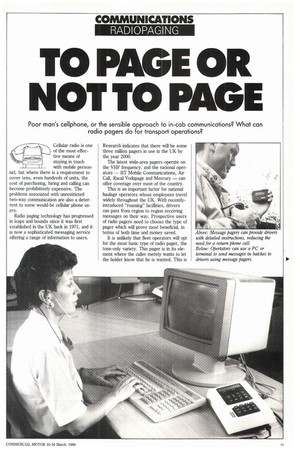TO PAGE OR NOT TO PAGE
Page 41

Page 42

If you've noticed an error in this article please click here to report it so we can fix it.
Cellular radio is one of the most effective means of staying in touch with mobile personnel, but where there is a requirement to cover tens, even hundreds of units, the cost of purchasing, hiring and calling can become prohibitively expensive. The problems associated with unrestricted two-way communication are also a deterrent to some would-be cellular phone users.
Radio paging technology has progressed in leaps and bounds since it was first established in the UK back in 1971, and it is now a sophisticated messaging service offering a range of information to users. Research indicates that there will be some three million pagers in use in the UK by the year 2000.
The latest wide-area pagers operate on the VHF frequency, and the national operators — BT Mobile Communications, Air Call, Racal Vodapage and Mercury — can offer coverage over most of the country. This is an important factor for national haulage operators whose employees travel widely throughout the UK. With recentlyintroduced "roaming" faciflities, drivers can pass from region to region receiving messages on their way. Prospective users of radio pagers need to choose the type of pager which will prove most beneficial, in terms of both time and money saved. It is unlikely that fleet operators will opt for the most basic type of radio pager, the tone-only variety. This pager is in its element where the caller merely wants to let the holder know that he is wanted. This is more likely to be the case on large industrial complexes, in hospitals or other places where individuals or groups of people are "roving" on-site with relatively easy access to a phone. Service engineers or salesmen may be bleeped in the hope that they can use the customer phone to make the return call.
Despite their limitations, tone pagers are still a popular option due to the relatively low purchase or rental costs, and also because the message transmission method is so straightforward. Each pager is issued with an exclusive telephone number which, when dialled in the normal way on the public telephone network, causes a signal to be sent to a series of transmitters. These convey the message by radio waves to the pager at the cost of an ordinary telephone call.
The numeric pager is also unlikely to offer the ideal solution to the communications problems facing a company running a national vehicle fleet, although it is undoubtedly a useful tool for some organisations. A numeric pager is equipped with a small liquid crystal display (LCD), and has features which, for example, allow the user to store messages or to receive them silently with or without a tone alert. The messages come in the form of a phone number which the recipient is then expected to contact. Clearly this would not suit the long-distance lorry driver who may be a long way from a phone, or in a hurry to reach his destination.
Of the various options on offer, the message pager is most in demand. Mes Above: Message pagers cannot be contracted directly by telephone. They are reached by calling a message bureau, or using a dedicated computer.
Right: Large network paging operators run 24-hour message bureaux for sending messages to the required pager.
sage pagers, often termed "alphanumeric" pagers, are pocket-sized radio receivers which can display up to 32 characters on an LCD; each message can be up to 80 characters long.
Air Call's top-of-the-range pager also has a 1,200 character memory, enabling it to store messages so that they can be recalled or consulted repeatedly.
On receipt of instructions which might be to alter a route immediately, or to avoid heavy traffic delays, the pager holder need not stop to make a phone call. He may even choose to disregard the message, or decide that it can wait until later. In this context, it is worth noting that up to 40% of the average phone bill is accounted for by return calls. Instructions transmitted to message pagers are uniquely personal; there is no need for anyone other than the sender and recipient to know their content.
In contrast to tone pagers and most numeric pagers, which are contacted directly by telephone, message pagers must be contacted either through the relevant network paging operator, or by using computers and dedicated terminals. If the former access method is used, the message sender dials a message bureau, dictates the number of the pager he wishes to contact and the message. An operator then inputs the information via a computer, and the message is relayed to the pager in question in seconds.
If, however, a company wishes to have more control over the message transmission process, then it may opt for the direct access method. Using a PC or terminal is more convenient, enables messages to be sent in batches, reduces airtime charges and ensures confidentiality.
In addition, most transmission hardware comes equipped, or is easily fitted with printers. This means that printed copies of all messages can be obtained. To make life easier for the recipient, some message pagers can be fitted with small printers which can then produce hard copies of all incoming information. This is useful when the pager's memory cannot cope with the number of messages it receives, or if there is a requirement for employees to produce time/job reports.
by John Abbott, marketing manager, Air Call Communications








































































































